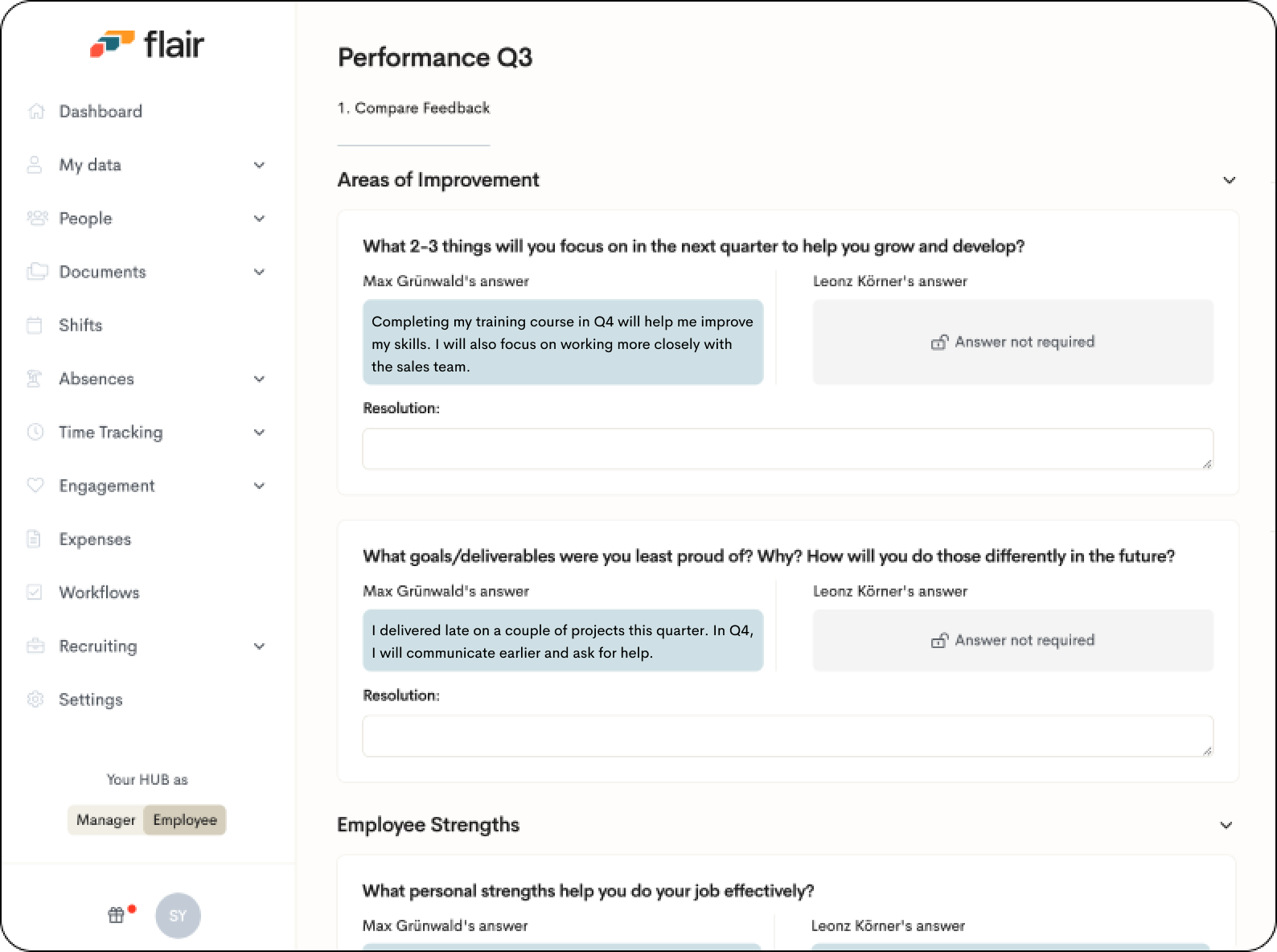Origins to Innovation: Cloud Computing's Impact on HR
Do you know why it's called cloud computing and are you aware of the benefits to HR?
- 06 Jun 2024
- Max 11 min read
The Number One HR Solution on Salesforce
People are your most valuable assets. And high employee engagement helps unlock their potential. This article focuses on how to improve employee engagement by explaining what it means, why we should care about it, and how to achieve better results with your workforce.
In recent years, more employers are starting to appreciate the benefits of employee engagement and its impact on job satisfaction, employee well-being, and business outcomes. The first step to more engaged employees is to define what this means and how you can measure it.
Employee engagement is the emotional commitment the employee has to their organization and its goals. Highly engaged employees feel a stronger connection to their coworkers and employer. They are therefore more likely to go the extra mile and do more to help your company succeed. This extra effort is also known as ‘discretionary effort’; it is the work employees do because they want to, not because they have to.
A lack of employee engagement, on the other hand, can have a detrimental effect on retention. It costs companies time, money, and resources to find new employees that fit their expectations. Besides this issue, organizations with disengaged employees often experience higher absenteeism. Both of these factors affect business performance and customer satisfaction. If we don’t take good care of our workers, we cannot expect them to deliver excellent customer service. That results in lower customer satisfaction and fewer sales.
Employee engagement means that an individual is fully committed to their work, wants to contribute to achieving company goals, and is willing to go beyond the call of duty.
Employee satisfaction measures how content an employee feels about their job. It depends on how much the job meets the employee’s expectations and is heavily influenced by the employee experience.
While the two terms are closely related, they are not interchangeable. An engaged employee is almost certainly satisfied with their job, but it goes further than that. They feel an emotional connection with your company’s goals, vision, and mission and embrace company values.
At the same time, satisfied employees are not necessarily engaged employees. They are happy to do their job and stay with the company, but they will not go beyond what is expected of them if they are not sufficiently engaged.
An engaged workforce benefits a company at every stage of the employee life cycle. For example, a highly engaged employee is more likely to learn faster in the onboarding process. They are more likely to stay with the company for longer and are more motivated to develop their skills.
What’s more, an engaged employee can be an advocate for your company, improving your reputation as an employer and helping attract new, similarly motivated talent. They may continue to be positive about your company even once they have left.
Research shows disengaged employees are more likely to quit than those who feel a connection with the company and enthusiasm for what they do. This can prove expensive. According to a Gallup study, the cost of replacing an employee ranges between 50% and 200% of that employee’s annual salary. If your human resources department is finding it difficult to convince employees to stay, focusing on engaging them better might be the solution.
When employees feel more valued and know that their opinions matter, they are prepared to work harder for the company they care about. This increase in productivity will positively affect your company’s bottom line. One of the ways to boost productivity and to make your employees' lives easier is to use a telephone clock-in system. Thus, your employees will be relieved of the stress of using too much paperwork and make regular adjustments on the timecards, which will lead to speeding up completion of the assigned tasks and make handling HR more straightforward. And that is a win-win scenario, since it benefits both the employees and the managers. Everyone can stay updated in a simple and convenient way, and that will not only lead to increased productivity and retention, but it will also save a lot of time.
Mood and morale quickly spread throughout teams within an organization. This is a positive thing when morale is high and everyone feels like they’re being treated fairly and equally. But if workers are not engaged with their jobs, the lower motivation can make its way around the company. This can negatively affect employee happiness and even lead to otherwise productive members of your workforce becoming disengaged or, worse yet, leaving altogether.
Employees who are engaged in their work are more likely to contribute ideas and think outside the box. This can contribute to company success when creative solutions are needed.
An engaged workforce is more likely to go above and beyond to ensure service quality and customer satisfaction. When employees feel a connection to their employer, they will put in extra effort to represent the company in the best possible way.
Research shows that when employees are engaged at work, they tend to miss fewer days of work. This is because they feel a sense of purpose and pride in what they do. There is no question that having more happy and satisfied employees leads directly to lower absenteeism and higher productivity.
When employees feel more engaged, they follow company policies more stringently. This includes taking the necessary health and safety precautions at work, such as wearing a hard hat or gloves when needed.
Employee engagement surveys are the easiest way to get employee feedback. Typical topics include company culture, compensation, perks and benefits, leadership, and collaboration. Using the survey results, HR leaders can develop engagement initiatives that improve the overall level of engagement.
Besides using surveys, you can also keep an eye out for other indicators of a disengaged workforce. For example, high employee turnover or increased absenteeism rates can indicate low engagement levels. However, it is better to act on employee feedback before these problems manifest.
Other methods include anonymous suggestion boxes, where employees can share their own ideas for improvements. And, of course, regular one-on-one meetings can give you a chance to discuss employee well-being and hear employee concerns directly. The key is to maintain a healthy work environment where employees feel comfortable giving honest feedback.

Anonymous surveys can give HR professionals valuable insights into how employees are feeling. You can send out larger surveys every 6–12 months or use quick 3-min surveys to regularly gauge team morale.
Here are some examples of questions you can ask in your employee surveys:
At the same time, you should avoid asking questions that could make the survey respondent feel uncomfortable. These include questions about the employee’s personal life or asking the employee for their opinion on a particular coworker or manager.
One of the most useful metrics for tracking levels of employee engagement is eNPS (employee net promoter score). You just ask one simple question: “How likely are you to recommend working at our company to your family or friends?”. The results enable you to identify promoters, detractors, and passives within your organization.
Pulse surveys are an excellent way to keep track of how employees feel by regularly sending out small sets of survey questions to monitor employee engagement over time.
Combining eNPS with pulse surveys and more comprehensive engagement surveys gives you a solid basis for your employee engagement strategy. You can learn more about how to act on feedback and improve employee engagement in this blog post.
You could also consider using employee engagement software to give you an overview of the relevant metrics. HR solutions such as flair allow you to send out employee surveys, track results, and record eNPS over time. You can also use them for goal setting, giving employees a clear view of what’s expected and allowing managers and employees to track performance. With the right software, you can create an effective action plan to help you reap the benefits of an engaged workforce.

There’s no doubt that employee engagement is important. But we should also remember that it is only one part of the picture. The most successful HR teams consider the entire employee experience. Nevertheless, ensuring that your workforce is engaged is a foundation for creating a positive company culture. By understanding what drives employee engagement, you can avoid issues such as absenteeism and employee turnover before they harm your business.
Join flair’s newsletter to receive the latest tips & trends in the HR world.

